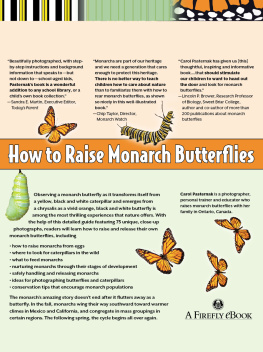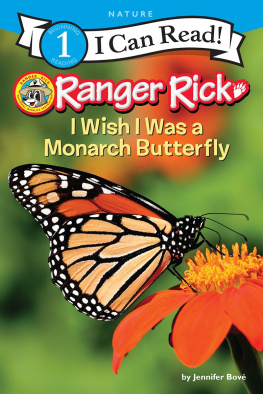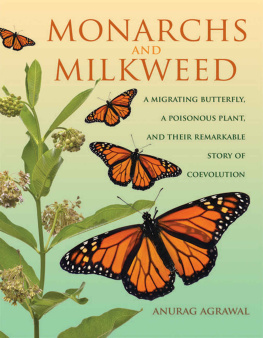CHASING MONARCHS
BOOKS BY ROBERT MICHAEL PYLE
Wintergreen: Rambles in a Ravaged Land
The Thunder Tree: Lessons from an Urban Wildland
Where Bigfoot Walks: Crossing the Dark Divide
Nabokovs Butterflies: Unpublished and Uncollected Writings (with Brian Boyd and Dmitri Nabokov)
Chasing Monarchs: Migrating with the Butterflies of Passage
Walking the High Ridge: Life as Field Trip
Sky Time in Grays River: Living for Keeps in a Forgotten Place
Mariposa Road: The First Butterfly Big Year
Letting the Flies Out (poems, essays, stories)
The Tangled Bank: Writings from Orion
Evolution of the Genus Iris (poems)
ON ENTOMOLOGY
Watching Washington Butterflies: An Interpretive Guide to the States 134 Species, Including Most of the Butterflies of Oregon, Idaho and British Columbia
The National Audubon Society Field Guide to North American Butterflies
The IUCN Invertebrate Red Data Book (with Susan M. Wells and N. Mark Collins)
Handbook for Butterfly Watchers
Butterflies: A Peterson Field Guide Color-In Book (with Roger Tory Peterson and Sarah Anne Hughes)
Insects: A Peterson Field Guide Coloring Book (with Kristin Kest)
The Butterflies of Cascadia: A Field Guide to All the Species of Washington, Oregon, and Surrounding Territories
First Yale University Press edition published 2014.
First edition published by Houghton Mifflin Company 1999.
Foreword copyright 2014 by Lincoln P. Brower.
Afterword copyright 2014 by Robert Michael Pyle.
Copyright 1999 by Robert Michael Pyle.
All rights reserved.
This book may not be reproduced, in whole or in part, including illustrations, in any form (beyond that copying permitted by Sections 107 and 108 of the US Copyright Law and except by reviewers for the public press), without written permission from the publishers.
Yale University Press books may be purchased in quantity for educational, business, or promotional use. For information, please e-mail sales.press@yale.edu (US office) or sales@yaleup.co.uk (UK office).
Drawing on title page by Thea Linnaea Pyle.
Book design by Anne Chalmers.
Printed in the United States of America.
Library of Congress Control Number: 2013954244
ISBN 978-0-300-20387-5 (pbk.)
A catalogue record for this book is available from the British Library.
10 9 8 7 6 5 4 3 2 1
FOR THEA
I feel drawn south again, into wild, fragrant places.
Vladimir Nabokov, letter to his mother, Elena Nabokov, August 15, 1929
What I wanted was guidance, a system of telemetry to ease the tension of not knowing what happens next.
Alison Deming, from #54, The Monarchs: A Poem Sequence
It is long after sunset when I look up in the twilight and see a monarch flying overhead, a small, black, fluttering form against the fading glow in the sky. It is headed south.
Edwin Way Teale, A Walk Through the Year
But most of all I shall remember the Monarchs, that unhurried westward drift of one small winged form after another, each drawn by some invisible force.... Did they return? We thought not; for most at least, this was the closing journey of their lives.
Rachel Carson, letter to Dorothy Freeman, September 1963
CONTENTS
FOREWORD
Lincoln P. Brower
I am delighted to welcome the new release of Chasing Monarchs by my good friend and master lepidopterist, Robert Michael Pyle. We have long shared an appreciation for the monarch butterfly and its complex migration biology. We have also long shared a deep concern for its conservation, and have worked together toward that end, including memorable travels in Mexico. Since Bob and I were both graduate students of the late legendary lepidopterist and professor of biology Charles Remington at Yale, I am particularly pleased that Chasing Monarchs is coming back into print with Yale University Press.
In the lyrical and engaging Chasing Monarchs, Pyle recounts his 1996 journey with monarchs as they migrated across the northwestern United States, southward through the Great Basin to the Rocky Mountains and finally to the Arizona border with Mexico. Pyles expedition was inspired by his questioning of what he calls the Berlin Wall model of monarch migration. The general consensus by the 1990s was that all monarchs that breed east of the Rocky Mountains migrate to overwintering sites in the Oyamel fir forests in central Mexico, whereas monarchs breeding in the western United States migrate to overwintering sites along the California coast. Accordingly, the Rocky Mountains were seen as a dividing line between what were assumed to be completely distinct eastern and western breeding populations. Gradually accumulating evidence did not always agree with this dogma, and Pylethe consummate naturalistdecided to follow individual monarchs and see for himself what was really happening in western North America. Chasing Monarchs tells of his nine-thousand-mile journey of discovery.
On his expedition, Pyle recorded the direction of flight of as many monarchs as he could find. As he had predicted, a substantial number of the sixty-two individuals showing directional flight were headed not toward the California coastal areas but toward the south and southeast. Several research papers published since the original publication of Chasing Monarchs support the hypothesis that the eastern and western populations are not completely separated. Molecular genetic studies by several investigators have found little genetic differentiation between the eastern and western populations. Definitive evidence of some degree of population mixing comes from the Southwest Monarch Study, which has tagged a large number of monarchs in Arizona since 2003. Arizona butterflies have been recaptured at overwintering sites both in California and in Michoacn, Mexico.
The emerging evidence that some monarchs that breed west of the Rocky Mountains do migrate to central Mexico raises a new series of intriguing questions. The most obvious is, how frequent is the interchange of butterflies between the two populations, and is the movement primarily in one direction, or in both directions? Do the western adults that winter in Mexico remigrate to the West, or do some of them fly into Texas and mix with the eastern North American migrants? Likewise, how often do eastern migrants get caught in winds that carry them into the western range, as Pyle and I suggested in a coauthored paper in 2004? Has what Pyle called the Berlin Wall model been dismantled, or does it have a few cracks? Once these questions have been answered, a plethora of genetic, evolutionary, and ecological questions can be addressed.
I hope that there will be sufficient time, and sufficiently large monarch populations, for scientists to pursue these investigations. In 1980 Pyle and I recognized that the monarch butterfly migration and overwintering behavior had become an endangered biological phenomenon. Degradation of the Oyamel forest was threatening the overwintering enclaves in Mexico, and real estate development in California was destroying several of the west coast wintering sites. Both Pyle and I were also concerned about the increasing use of agricultural herbicides, which exert massive collateral damage by killing the butterflies nectar sources as well as the milkweeds that are the only plants that monarch caterpillars are able to eat. In the decades since, while the popularity of the monarch butterfly has soared, its numbers have not.
Next page







